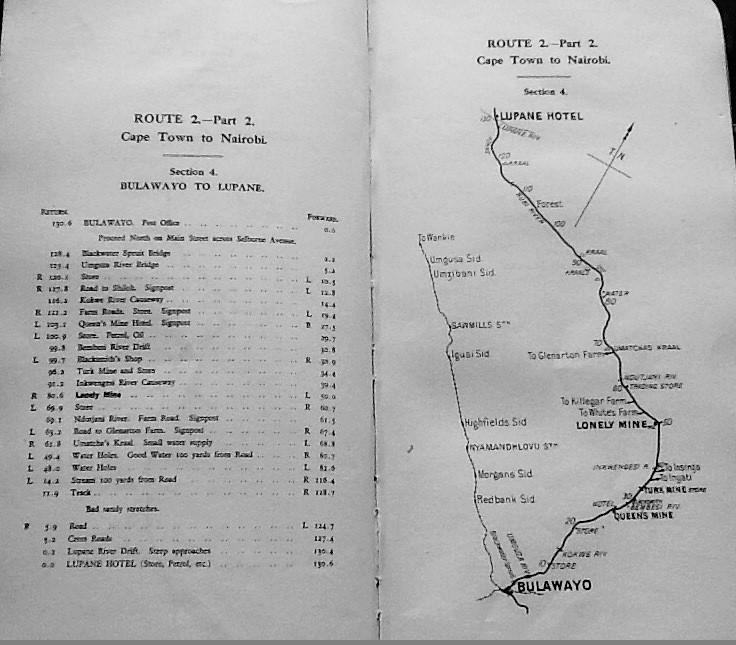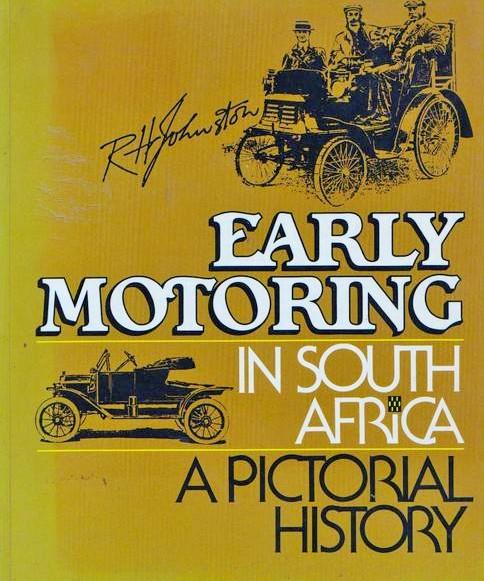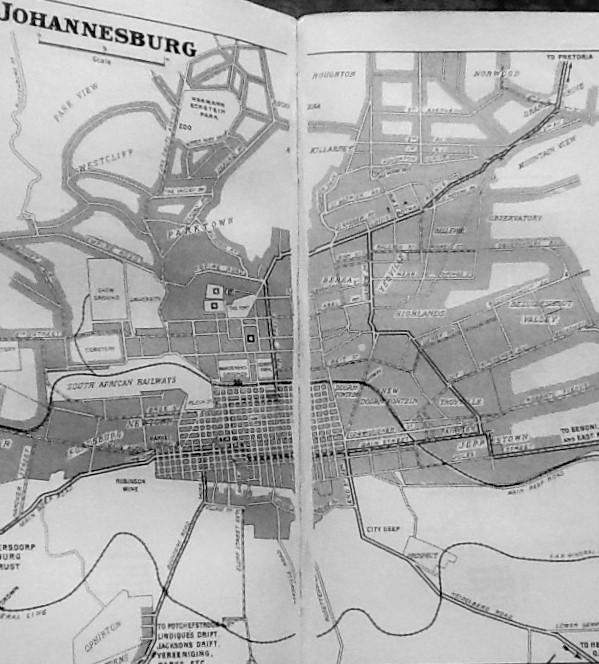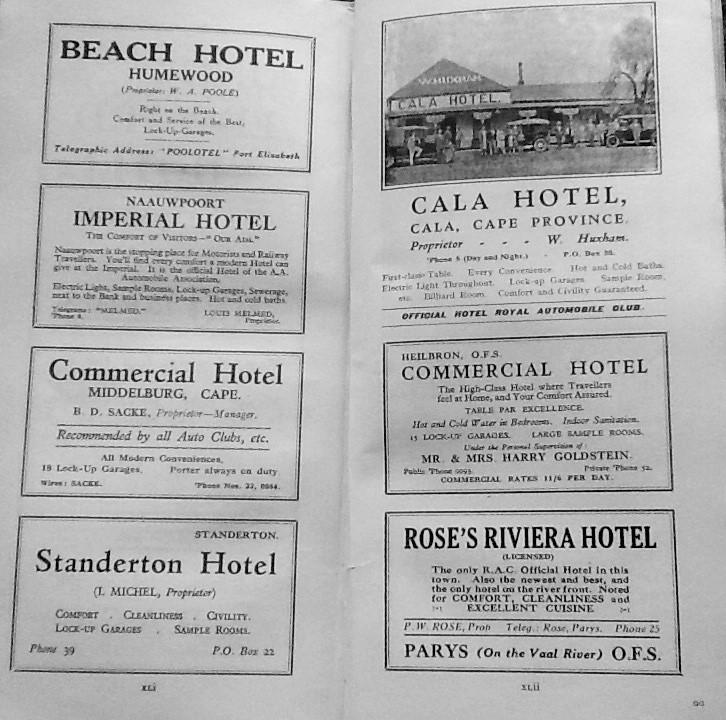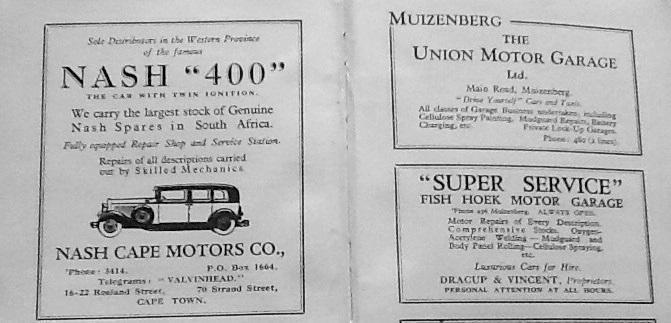
Royal Automobile Club of South Africa, Route Book, 7th edition, 1930 hard cover, 260 pages plus adverts.
Sometimes an odd, old and well-worn volume turns up that is irresistible and is a must for an Africana collection. This small, thick hard cover and very handy volume was the "vade mecum" for all intrepid motorists adventuring through Africa in the 1930s. It was priced at 25/- (twenty five shillings, a not inconsiderable sum of money when compared to average artisan wages of perhaps £4 a week). It still survives as a sturdy much thumbed car book. Originally it came with a fold away map tucked into the pocket at the rear. It must have been well used and kept in the cubby hole. This was not a book for a library. It was the travel atlas for Southern Africa of its day.
Book cover
This route guide provides a series of simple strip maps covering some 87 routes, effectively covering South Africa and way to the north to the Victoria Falls, Nairobi, to the north west to Windhoek and to the East to Lorenco Marques. Each strip map shows a starting point and a meandering route to the next town, with distances marked in for forward and return travel, until you arrive at the destination point. For example, to travel from Cape Town to Durban (Route 1) required progression through 11 sections. Distance between towns and cross roads was shown in carefully calibrated mileage. Early cars had milometers, but the value of milestones becomes apparent, though actual milestones were obsolete by the time the car arrived.
Considering the date the surprise is how geographically integrated the African continent was in 1930. How extraordinary that it was possible to journey by car from Cape Town via Johannesburg and on to Nairobi, a distance of 3833 miles, by the most direct route at that date. Though one wonders how many were brave adventurers. In 1930 most roads would have been dirt red African soil, rough tracks. Garages could be up to 600 miles apart once you were into Africa beyond the Union, but Africa was certainly not the dark continent. You needed to be your own mechanic, carry spares, food supplies, camping gear and a supply of petrol. Shell, Atlantic Petrol, Pegasus, Mobil Oil and Texaco were the familiar brands, along with Castrol, Mobil, Texaco and Vacuum oil. The main roads between towns usually ran alongside the railway lines. The Johannesburg to Durban route ran through Heidelberg, Balfour, Greylingstad, Standerton, Vrede, Warden, Harrismith, Ladysmith, Colenso, Estcourt, Mooi River, Howick, Maritzburg, Inhanga, and Pinetown before you caught your first glimpse of the sea and arrived in Durban. That was a 414 .5 mile journey.
This RAC book takes one back to an earlier era. Turning the pages of these many strip route maps of 1930, are rich in detailed information about place names and distances. Here you are guided from Cape Town to Windhoek along a West coast route. Or you could try Pretoria to Lorenco Marques. The names alone bring history to life and makes one appreciate the mix of pioneering, colonial, and indigenous origins. The route from Messina to Nairobi meant you encountered places with names such as Gwanda, Lonely Mine, Zimba, Pemba, Broken Hill, Chewefwe Farm, Mpika, Kasama, Abercorn, Iringa, Dodoma and Arusha. Here is the African cartographic appeal. There is romance in the names.
Bulawayo to Lupane - Part of the Cape Town to Nairobi route
This is a book to be studied and place names of Africa savoured. Take an armchair route journey in conjunction with R H Johnston's Early Motoring in South Africa, a pictorial history (published by Struik in 1975), the black and white photographs show what travel in the early days of motoring must have been like.
Book cover
The strip maps enable you to imagine places and remember towns you visited in your childhood. In the rural areas travel was one long tough safari crossing rivers over rudimentary bridges, by pontoons and drifts. In 1930, you needed to change your own tyres, dig yourself out of mud or hunt a buck for the pot. Roads in the country were no more than rutted tracks. In the cities one could stay at one’s club or in a comfortable hotel.
By the decade of the thirties motoring had come of age. A local car industry had emerged during the nineteen twenties with Ford and General Motors having established assembly plants in Port Elizabeth. Originally the preference of affluent car owners was to buy British or European cars, but the American manufacturers gained an edge through mass production, economies of scale and a drop in price. The automobile industry became part of the industrialization drive, but with the PACT government after 1924 linking import tariffs to the employment of white labour (it was a policy that revealed its short comings very quickly for as white labourers became industrial employees so too did black workers).
General Motors produced vehicles such as Chevrolet tourers, Cadillacs, Buicks, Oldsmobiles and GMC Trucks. Ford produced the Model T and Model A. American cars were known for their sturdy, low prices and length engine life. There was a huge variety to choose from - trucks, roadsters, sedans, tourers, coupes. The technical advances of the decade produced synchronized mess gear boxes, front wheel drives in addition to, back wheel. Drives and state of the moment gears and clutches. The first traffic lights were introduced in towns in the thirties and were given the unique South African term of “robots”.
In addition, the handbook also contains a section of some 89 town plans of the then principal towns of the Union of South Africa, from Aberdeen to Zastron. The Johannesburg map is a double page spread and is not one I had previously encountered. The principal arterial roads are much as they are today. These town maps are an invaluable source of information for tram, bus road and railway routes. In 1930 the city's mines, such as Robinson Mine and City Deep ensured that active mines lay within the city's boundaries. The Town plans show hospitals, churches, police stations, hotels, garages, cemeteries, railway stations, post offices, and town halls.
The Johannesburg map
Another fascinating aspect of this 1930 Route Book are the advertisements for garages, petrol, tyres, car agencies, and over 70 hotels and restaurants meaning the motoring community was spoilt for choice in the principal towns and cities. The Carlton Hotel marketed itself with a somewhat staid text but emphasizes that "every bedroom has a telephone" and its delights included Turkish baths, hairdressing saloons, an orchestra and weekly cabarets. A choice hot water spa was the Calendon Baths, “the premier Holiday and Health resort of the province” with electric and massage treatment available. Port Elizabeth invites you to call to see the new factory for General Motors and you are invited to "see our cars and trucks being built by South African Workmen under ideal conditions and with the most up-to-the- minute equipment."
An example of adverts appearing in the Route Book
Here is 33 years of progress as the first automobile imported to the Transvaal was a Benz from Germany brought to South Africa by John Hess, a Pretoria merchant; it was exhibited as the First Motor Car in South Africa and was driven in style around the Wanderers track in Johannesburg in 1897.
In 1902 Frank Connock showed off his first car, a French, twin cylinder, Gladiator. Connock set up the first motor garage on Main St. Johannesburg. In 1904 Arthur Youldon of Johannesburg imported the first Ford from the USA and was told by Henry Ford that this two cylinder engine vehicle, priced at $850 was Ford’s first sale outside north America. (information in R H Johnston)
The Royal Automobile club itself had an interesting history. It was founded in Cape Town in 1901 as the Automobile Club and was the first motorists organization in South Africa. In 1911 it added the title Royal to its name with the conferring of a royal charter following the visit of the Duke of Connaught. There were many other motorists bodies in the early days and in 1930 the Automobile Association of South Africa was founded in Port Elizabeth, to bring cooperation and harmony to this area of interest. In 1965 the RAC of South Africa was taken over by the AA which is still in existence .
In the Transvaal, the Transvaal Automobile Club (the TAC) was formed in 1903 to foster “automobilism”. The club moved to Cooke’s Farm in Killarney in 1911 and developed sporting and social facilities. By 1930 it passed the responsibilities of “protecting fostering and promoting” the interests of the motorist to the newly formed Automobile Association. The TAC later became the Killarney Country Club but in 1970 the expropriation of its site by the Johannesburg City Council to make way for the M1, led the Club to relocate to Houghton close to the motorway, where it has a lease until 2040 (Killarney Country Club website).
In 1936 Johannesburg celebrated its Golden Jubilee and as part of the publicity for the 1936 Empire exhibition a car race from Nairobi to Johannesburg, the Nairobi-Rand road race over 2700 miles set the scene. 41 cars left Nairobi on 26th October and the first vehicle home was, a Terraplane from Kenya. Although it was hoped that the race would become an annual event it was never repeated. It was the Dakar rally of its day! Cars of the thirties, like aeroplanes were another expression of speed the fluidity and thrill of the art deco design and era. 1936 saw the publication of the 8th Edition of the RAC Route book.
I purchased my copy of my 1930 RAC guide, serendipitously at a city library book sale. It was my find of the day. But I notice that copies, in varying conditions and editions, are available on the Bid or Buy website at about R300. Another quaint and curious publication of the RAC was its 1949 book, Legal Notices on Motoring, compiled by Andrew C Fuller. It presents 600 decisions relevant to motoring that had by that date been delivered by the South African Supreme court.
My copy of the RAC handbook is missing the fold out map, but still preserved though perished are the red and blue book mark ribbons. Nevertheless, this is a wonderful little book find as a source of reference and to open up the imagination to the travel experience of some 85 years ago prior to motorways, highways and GPS navigation. This is a bit of authentic raw material to take you back to another era. My ambition now is to acquire the 1st to 6th editions of the RAC route guides and preferably ones with fold out maps intact.
Kathy Munro is an Honorary Associate Professor in the School of Architecture and Planning at the University of the Witwatersrand. She enjoyed a long career as an academic and in management at Wits University. She trained as an economic historian. She is an enthusiastic book person and has built her own somewhat eclectic book collection over 40 years. Her interests cover Africana, Johannesburg history, history, art history, travel, business and banking histories. She researches and writes on historical architecture and heritage matters. She is a member of the Board of the Johannesburg Heritage Foundation and is a docent at the Wits Arts Museum. She is currently working on a couple of projects on Johannesburg architects and is researching South African architects, war cemeteries and memorials. Kathy is a member of the online book community the Library thing and recommends this cataloging website and worldwide network as a book lover's haven.


